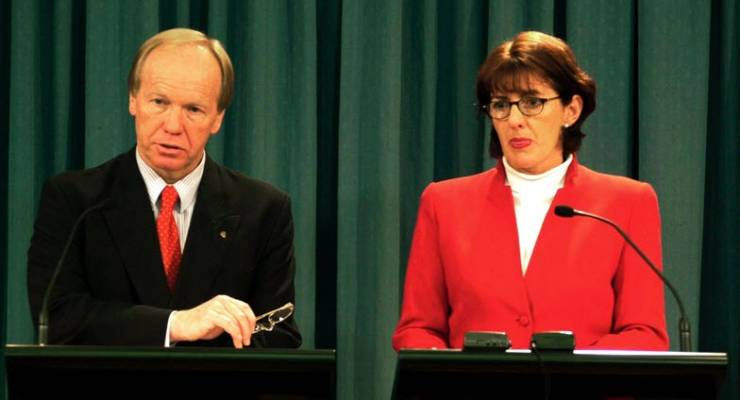
Queensland premier Peter Beattie & Aboriginal Affairs Minister Judy Spence in 2002
From the late 19th century to as late as the 1980s, state governments across Australia controlled the wages and savings of the majority of Aboriginal and Torres Strait Islanders in Australia, under various “protection acts”. Protection acts controlled various aspects of Indigenous Australians’ lives, including where they could live, where they could travel and who they could marry. Such acts invariably also regulated, in minute detail, the kind of work they could do, and what happened to their money.
Their wages were usually paid into a trust that Indigenous workers couldn’t access — and in many, many cases, this money never reached those who had worked for it. How to address this historical injustice has long been a topic of debate. In 2002, the Beattie government in Queensland introduced the Indigenous Wages and Savings Reparations Offer (the reparations offer) for the reparation of money to Indigenous workers who had their wages and savings “controlled” under protection acts. It set aside $55.4 million for the scheme, though Beattie conceded at the time that it was far less than some estimates of what was owed.
On September 29, 2017, the Queensland government’s reparations scheme closed to new applications, and it will continue to assess claims it has received until June 2018.
The recently re-elected Labor government is not extending the program. This is a bipartisan position, incidentally; opposition spokesperson for Aboriginal and Torres Strait Islander partnerships and multicultural affairs Steve Minnikin MP told Crikey the LNP would not have made changes to the reparations scheme had they been elected.
However, this is an issue that is unlikely to go away. In the middle of this year, a huge class-action lawsuit was initiated against the Queensland government on behalf of thousands of Indigenous workers who had been covered by the policy. John Bottoms of BELaw, the firm leading the action, says there are many issues with the government’s scheme, not least of all the requirement that any recipients sign a deed of release, exonerating the government from any further claims. Indeed, among those involved in the suit (Bottoms says it’s a little over 3500) are people who have received payments from the reparations scheme.
“The government is dangling four thousand to nine thousand dollars in front of people’s faces; often these guys are very old, and in very remote areas, English isn’t their first language. They don’t know what they’re missing out on by agreeing,” he told Crikey.
A 2006 Senate report on stolen wages criticised the Queensland scheme for the inadequacy of the money offered, the requirement to sign a deed of agreement indemnifying the government, and the inability for the relatives of affected workers who had passed away to access the scheme. All of these aspects of the scheme are still in place.
Western Australia didn’t have a reparations scheme in place until 2012. It ran for nine months, was subject to series of limitations (descendants of affected workers, pastoral workers and others were exempt) and offered successful applicants $2000 each. A government whistleblower told ABC Background Briefing that the government had been deliberately delaying the scheme, waiting for claimants to die.
Following the Queensland action, Shine Lawyers began putting together information on claims in other states, particularly the Northern Territory, Western Australia and New South Wales. NSW and WA also had reparations schemes, but not the NT.
Jan Saddler, who is leading the action for Shine Lawyers, said there were a number of questions around how have governments calculated the amount of money that has been put aside for reparation schemes.
“It’s really not clear where they got these numbers from,” she said.
Asked by Crikey how the amount set aside for reparations was calculated, a Department of Aboriginal and Torres Strait Islander Partnerships spokesperson did not go into detail, merely confirming that $55.6 million was the original allocation announced by Beattie for the reparations process in 2002.
Saddler said it was also unclear what lengths governments were going to to ensure that those affected knew their rights.
“How can we be satisfied they reached the people who need to be reached? It is incumbent upon the governments making these offers to ensure people are fully aware what their rights are, that they understand what they’re signing up to, and how their options will be affected going forward.”








Crikey is committed to hosting lively discussions. Help us keep the conversation useful, interesting and welcoming. We aim to publish comments quickly in the interest of promoting robust conversation, but we’re a small team and we deploy filters to protect against legal risk. Occasionally your comment may be held up while we review, but we’re working as fast as we can to keep the conversation rolling.
The Crikey comment section is members-only content. Please subscribe to leave a comment.
The Crikey comment section is members-only content. Please login to leave a comment.